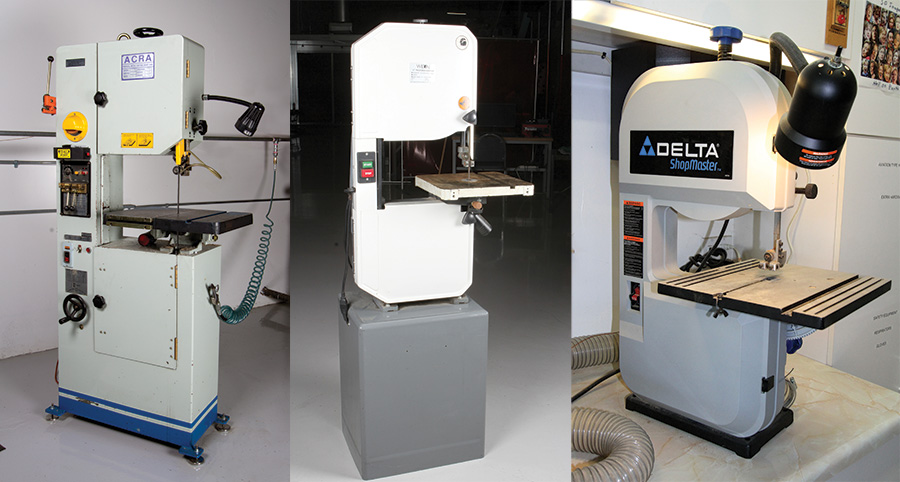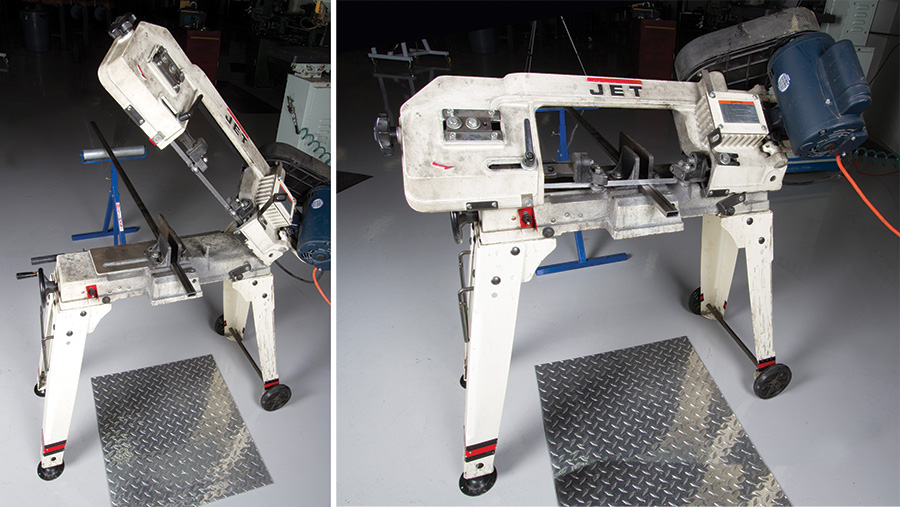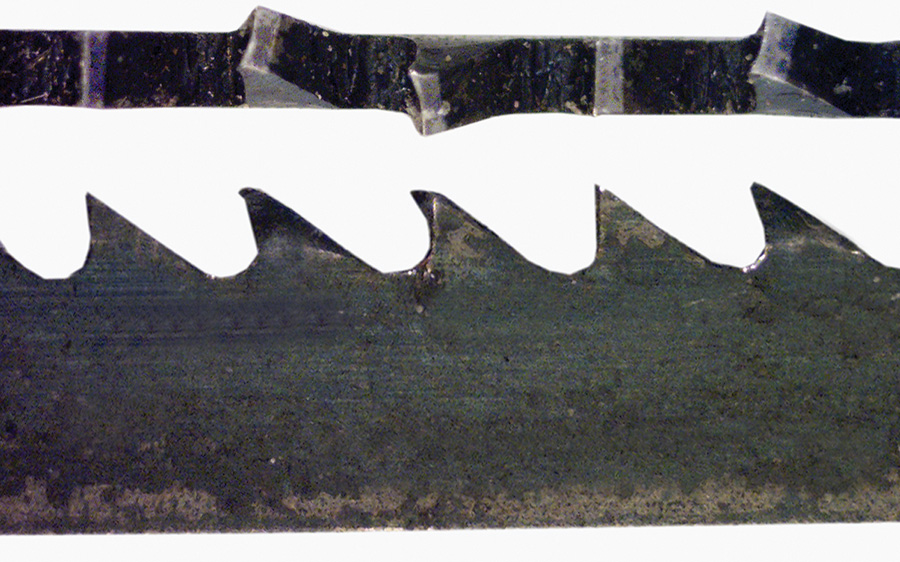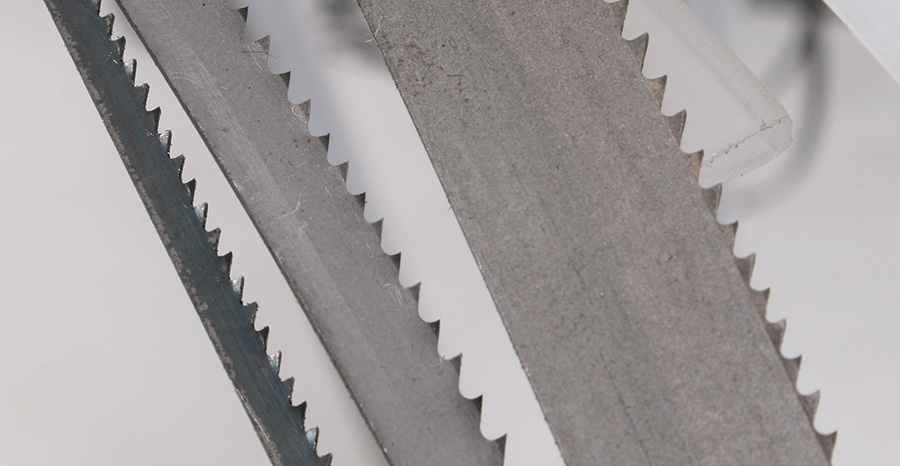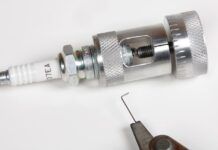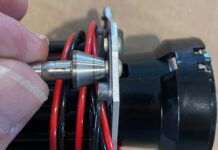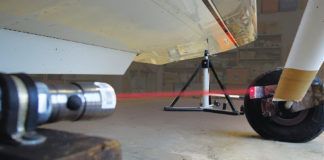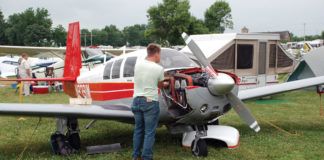Mankind could not have made it out of the Stone Age to modern society without saws. The idea of using pointy teeth to cut stuff dates back to at least 3000 B.C., if not earlier. Until the advent of the practical bandsaw in the mid-19th century, sawing was grueling back-and-forth drudgery. The bandsaw, initially powered by water, then steam or gas, and finally electricity, put an end to that drudgery.
Bandsaws come in a crazy array of shapes and sizes, but they all do the same thing: cut big stuff into small stuff with pointy teeth on a continuous steel band. The teeth can be really big and spaced apart, like a sawmill blade for slabbing logs, or really small and clustered very close together, like a diamond-grit blade for cutting glass or ceramics. Bandsaws are not precision machines. They are a “first operation” machine. In other words, they are for rough cutting large or long pieces to size for further processing.
Examples of vertical saws. L: An industrial grade metal-cutting bandsaw with variable speed control. M: A dual-range (metal or wood) 14-inch vertical bandsaw on a cabinet base. R: A small benchtop model for wood or composites.
Bandsaws for the home shop come in two basic flavors: horizontal and vertical. Horizontal saws consist of a base frame with a pivoting saw head. The piece to be cut, usually a long length of tube or bar, is clamped to the base via an integrated vise. Cutting commences with the saw head being lowered into the material. Horizontal saws are self-feeding in that the cutting takes effect (usually) by gravity. On small saws, the feed rate is made slow or fast by adjusting the tension of a counter-spring. On larger saws the feed rate is controlled by an adjustable hydraulic damper. Horizontal saws are one-trick ponies: they excel at rough cuts on long stock. Once set, they can be left unattended, and when finished they will automatically turn off.
The venerable 4×6 horizontal bandsaw is a popular choice for home shops. Although it touts the ability to “convert” to a vertical saw, it’s marginally useful in that configuration. This basic design is sold under a variety of different brand names.
On a vertical bandsaw, the saw head and table are fixed and you feed the work into the blade. This allows you to make straight cuts, follow patterns and curves (how tight a radius depends on the width of the blade), and by tilting the table, you can make angled and beveled cuts.
Vertical saws are sized in terms of three key factors: 1) their throat size, which defines how wide a cross-cut you can make, 2) the maximum height between the blade guides and the table, and 3) the horsepower of the motor.
On a horizontal saw, the capacity is defined by the largest piece of stock that can be cut. For example, the classic horizontal saw for the home shop, the 4×6, can cut pieces 6 inches wide x 4 inches tall.
The cutting capacity of a vertical saw is determined by the width of the throat (W) and height of the guides (H).
A vertical saw can do anything a horizontal saw can do. For most homebuilders, that makes a vertical saw the practical choice. Vertical bandsaws range in size from the diminutive benchtop variety to mega-size monsters.
Small benchtop saws are usually for woodcutting only, but they can be used to cut fiberglass or carbon-fiber lay-ups, too. Attempting to use them on metal, including aluminum, will ruin the blade in short order. Aside from the obvious—wood being softer than steel—bandsaws for wood run at very fast speeds: 1500 to 3000 feet per minute (fpm) or more compared to metal-cutting saws, which run around 50 to 300 feet per minute. The blades are different as well. Blades for woodcutting are thinner and more flexible than comparable metal-cutting blades.
The teeth on bandsaws are bent in an offset pattern called set to cut a kerf wide enough to prevent binding. This blade has what is called an alternating set: a straight tooth followed by one tooth set left and one tooth set right.
Blades have to be flexible enough to resist cracking from the continual bending around the wheels (under tension, no less), and at the same time, the teeth have to be hard enough to stay sharp for a reasonable amount of cutting. That’s a tall order! Carbon steel blades are a good compromise for low cost with good flexibility, but have somewhat limited cutting life. It’s not uncommon for the edge of a carbon blade to dull noticeably after a few minutes. Better blades for metal cutting are the bi-metal variety. As the name implies, they are actually two metals welded together—a tough strip of high-speed steel is welded to a flexible band of low-carbon steel. The combination creates a blade with long-lasting teeth and a fatigue-resistant band. Blades for wood can also be carbon steel, but silicon steel blades are better. Silicon steel provides a good balance of flexibility and reasonable cutting life. How long a blade lasts (how long it stays sharp and cutting straight) depends on a many factors: the type and thickness of material you’re cutting, the blade speed, the feed rate, and so on.
A sampling of bandsaw blades, from left to right: a 1/8-inch wide scrolling blade, a ¼-inch wide 10-14 bi-metal blade, and a ½-inch wide 10-14 bi-metal blade.
Rules of Thumb
There are so many rules of thumb for bandsawing you could do with a few extra hands! Here are a few:
Rule of thumb: Read and obey the safety warnings that came with your saw.
What it means: This rule of thumb is designed to keep you from sawing off a thumb (or finger or a hand for that matter). Be careful and always wear safety glasses!
Rule of thumb: Wear leather or canvas work gloves when changing or handling blades.
What it means: Replacement blades usually come coiled-up and shrink-wrapped in plastic. Coiled blades have a lot of spring to them and can get away from you when you uncoil them.
Rule of thumb: Always have at least three teeth in contact with the workpiece.
What it means: This applies to thin stock in particular. For example, using a blade with four teeth per inch (TPI) on 1/8-inch steel plate would result in only one tooth in contact with the material. This can put undue stress on the blade. You could end up shearing off teeth or snapping the blade.
Rule of thumb: Big, thick pieces take patience and a coarse blade.
What it means: No matter how new or how sharp the blade, big thick pieces of solid metal take time to saw. Use a coarse-tooth blade for these occasions, feed the work slowly, and be careful. If the work starts getting hot, stop and let it cool down. Use an appropriately coarse blade for thicker material, such as a 3 TPI blade for one-inch or thicker solid stock. Using too fine a blade to cut thick stock will cause the gullets (the cavity between the teeth) to clog up with swarf, which will lead to overheating, and cause the blade to dull in no time.
Rule of thumb: The harder the material, the slower the blade speed.
What it means: Steel and steel alloys use the lowest speed (50 FPM). As you move down the hardness scale, use progressively higher speeds: for aluminum 300 to 1000 FPM and for wood 1000 to 3000 FPM. There is a great speed-and-feed-by-material chart at www.sawblade.com.
Rule of thumb: Let the blade do the cutting.
What it means: Don’t force the cut. A sharp blade should produce clean chips and a straight cut. If the cut is drifting off line or you have to push hard to generate cutting action, the blade is probably dull, which leads us to the next rule:
Rule of thumb: Change blades like someone else is paying for them.
What it means: Don’t wait until a blade is so dull that it would have a hard time cutting balsa wood. Blades are relatively cheap so put on a new blade as soon as the cutting action diminishes.
Rule of thumb: Loosen the tension on the blade when not using the saw.
What it means: Blades last longer when the tension is relaxed between use.
Rule of thumb: You can use a metal-cutting bandsaw with a metal-cutting blade to cut wood, but not the other way around.
What it means: Metal cutting saws work fine for the occasional wood piece. If you find yourself sawing wood more than 25 percent of the time, it might be a good idea to invest in a bandsaw dedicated to wood.
Closing Thoughts
Several manufacturers offer wood/metal saws. These saws have a gearshift mechanism to change the speed range back and forth between “fast” for wood and “slow” for metal. They cost more than a comparable wood saw, but somewhat less than a full-featured metal cutting saw, and they are worth considering if space is an issue in your shop. If space is not an issue, you might consider a dedicated metal saw and a dedicated wood saw. This is what I have found more than a few times during my visits to different shops around the country.
Changing the range on this dual-speed wood/metal saw is a simple matter of moving the triangular-shaped knob.
Prices for a new benchtop vertical saw for wood start at $175. Around $500 buys you a floor model with an open stand, and around $900 a saw with a closed stand. Prices for vertical saws with the gearbox feature (wood/metal) start at around $1,400 (floor models only). Metal-only vertical saws sell for $2,000 and up. These usually include a blade welder for making your own blades from coil stock (that’s yet another article). Buying used is an option worth considering. Generally saws don’t get too abused, or if they are abused, the damage is often only superficial. Horizontal saws start at $350 for the small 4×6 models and go up (and up!) from there.
Tuning-up and maintaining a bandsaw is a subject way too complex for the time and space available. If you’re interested in the subject, I suggest the Carter Products web site. They are a popular supplier of bandsaw guides and other accessories, and they also offer an extensive collection of books and videos on the subject (www.carterproducts.com).
Carter Products also has a tune-up video posted on YouTube. The presenter shares some unique thoughts on bandsaw adjustments that run contrary to some old traditions. It’s very interesting.
Thanks to Phil Hooper and Billy Griggs for assisting with this article.

